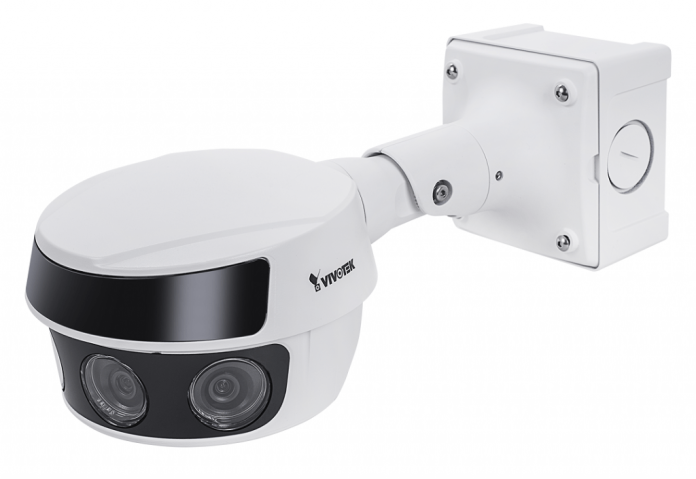When it comes to choosing camera form factor it can be hard to know what’s best in larger applications, PTZ or multi-head. Complicating the options further still are multi-head cameras with integrated central PTZs.
There’s a lot to like about multi-head cameras. Multiple sensors mean a wide angle of view without excessive pixel spread, which can impact on image quality and depth of field. But there are also applications where there’s no substitute for optical zoom – the ability to go 36x zoom and retain full HD is sweet. But this power comes with a trade-off.
Under optical zoom, the deeper into the scene you go, the more concentrated the pixels become as a percentage of the overall scene – this makes a 1080p 36x PTZ a powerful surveillance tool that combines huge reach with solid low light, white light and IR performance. The trouble with PTZs, however, is that when they are zoomed, you lose scene context and it’s not being recorded, either.
If your application includes static wide views in support of PTZs used by operators in real time then this is not such an issue. But there are some applications where a wider view with enough pixels for reasonable depth of field is the performance end users most often need.

The key to camera choice should always be operations and according to Farshid Parhizkari of Vivotek, the perfect applications for multi-head cameras are big.
“Multiple head cameras are designed to provide more coverage for large areas – these cameras are perfect for Airports, both terminals and apron, large malls, schools and universities, traffic control, parking, big warehouses and yards like logistic sorting facilities, ports, customs and city surveillance,” he explains.
“A multi sensor camera, gives users a massive coverage from a single camera point instead of requiring 3 or 4 cameras and cabling. Users save on installation cost, licensing and storage costs – a multi sensor cameras need only one cable, one PoE port and one SW license.”
While there are techniques to installing multi-head cameras, the task is not as high touch as it used to be, according to Parhizkari.
“These days the installation is much easier thanks to automatic image alignment and better mechanical design,” he explains. “The installation of a multi sensor camera is as easy as installing a bullet camera.”

Something that has posed challenges in the past has been managing image streams. Different manufacturers have different ways of seamlessly managing image streams so as much as possible information can be displayed on standard monitors and video walls.
“Using the latest technologies we not only can manage the streams individually in terms resolution, compression, frame rate and bit rate, we can also use high resolution 4K screens or tablets to reveal the capacity of high-resolution stitched image, so when we zoom in digitally, we get enough PPM to review the incidents,” Parhizkari says.
“For example, we can record the video of VIVOTEK 20MP multi sensor camera at 25 Fps at very low bit rate by using H.265 and Smart Stream III compression technology and use the second stream at 4MP by using H.264 compression to put less pressure on CPU for decoding, however, using 4K screens and GPU decoding on monitoring stations are recommended. Using H.265 compression technology requires less CPU for recording because there will be less data received and processed by VMS server.”
Something that has raised questions in the past has been software stitching of multiple images into a composite view. In the past is has been tricky to ensure that camera heads line up perfectly and are set to generally identical settings to ensure continuity of colour, saturation, WDR performance. But according to Parhizkari, the process is now more streamlined.
“Today the stitching happens automatically in multi sensor cameras and the R&D and optics engineers do a lot of tests in the lab to make sure stitching can be adjusted with minimum effort,” Parhizkari explains. “However, the process depends on the number of heads and the resolution.
“Other important factors are installation height and distance to closest objects. The higher up 4-sensor cameras are installed, the less the image borders can be seen and at some points stitching is not visible at all. The VIVOTEK MS9321-EHV camera delivers super smooth seamless stitching to ensure the users have the best possible user experience a panoramic multi sensor camera can deliver.”

Installers have wondered in the past whether compression of multi-head camera streams achieved a low enough bit rate to ensure networks were not overwhelmed.
“You will be surprised with the average bit rate of our 20MP multi sensor camera in a busy scene – the VIVOTEK camera uses less than 6Mbps,” Parhizkari says. “And if the scene is not busy, the bit rate will drop to less than 1Mbps at 25 Fps.
What’s the perfect resolution per camera head for a multi-head camera if you want to cover a significant scene and retain good depth of field under digital zoom – say a DoF of up to 50 metres from the lens?
“We think for 50m DoF, each lens has to be minimum 5MP to provide enough PPM,” says Parhizkari. “Obviously, the focal length of the lenses and VFOV matters too, it means for higher PPM at 50m FoV we need to use higher focal length which decreases the VFOV significantly. This means finding a balance between VFOV and PPM depends on the scene and a customer’s expectation. Using 4K resolution camera heads will be better but the low light performance of 4K sensors is not as good as 5MP sensors yet, and providing 25Fps at, say 32MP (4x4K sensor), needs lots of edge CPU power and generate a higher bit rate. But, ultimately, 4x4K multiheads will happen.”
In Parhizkari’s opinion, should multi-head cameras be supported by cameras with tight focal lengths at choke points, or are we at a point with resolution where this is now unnecessary?
“It depends to the size of the scene that needs to be covered – for up to 50m DoF, 20MP is pretty good with fixed lenses,” he says. “We can deliver 48 horizontal PPM at 50m distance covering a 158m wide panoramic view with the VIVOTEK MS9321-EHV. At 20m distance the camera can provide 115 horizontal PPM and at 10m it can deliver 200 PPM which is enough to read a license plate.”
Multi-heads can be more expensive than single head cameras – how can installers show the cost balance is worth it and how can they ensure they continue to enjoy similar earnings when installing fewer cameras on a site?
“The price of a 20 MP camera is 4x that of fixed dome with similar resolution, so there would be no difference in the money that the installers can make on the camera but there will be one installation, one cable run and one camera SW license and configurations,” Parhizkari says. “However, when there are some budget limitations and some installation difficulties, multi sensor cameras can be the best solution for a hassle-free installation and a win-win result.
“They can also allow installers to compete against the competition – since the labour cost is one the major cost factors in ANZ, using multi sensor cameras can save end users at least 50 per cent when compared to multiple cameras – and the installation will take much less time, as well.”

Over at Axis Communications, Daniel McGee, believes multidirectional cameras have unique situational advantages.
“They can monitor multiple directions simultaneously thanks to independent positioning of camera heads that can be moved and rotated, allowing scenes to be captured in various directions with both wide and zoomed-in views,” he says. “This makes them well suited to a variety of scenarios indoors and outdoors, particularly for mounting on external corners or at the intersections of corridors and roads.
“Additionally, with multiple camera heads incorporated into a single unit, you achieve the benefits of several cameras while only having to purchase and install a single unit, pull one cable, and pay for one VMS license (depending on the camera and VMS).”
According to McGee, challenges can include physical size as well as positioning the camera heads in a way that provides the desired fields of view.
“The initial assessment determines whether a multidirectional camera is appropriate for that location,” he explains. “Once it has been established that it’s appropriate to utilize a multidirectional camera, there are features such as remote zoom and focus, auto levelling, wireless installations tools, etc, which may be used to alleviate some of the challenges encountered during installation. These challenges typically have to do with ensuring that each of the sensors is covering the intended field of view.”
McGee argues usage requirements have priority when it comes to stream profiles being pulled from a camera for display.
“This is especially true when it comes to multidirectional cameras and it is always in the interest of the manufacturer to ensure that the streams and profiles available are as flexible as possible,” he says. “As an example, a single multidirectional camera may offer multiple streams as well as different resolutions, aspect ratios, and frame rates from a single sensor. The camera might also offer the same variations as above but for a combined ‘stitched’ view which merges the views from all sensors into a single high-resolution stream.
“A user may not utilize all of the different streams available, but what is important is that the ones which the user needs are there as available options.”
When it comes to stitching, McGee says it’s important to differentiate between multidirectional and panoramic camera systems.
“Multi-directional cameras incorporate several camera-heads which can be repositioned in a flexible manner such as pan/tilt and zoom adjustments allowing each sensor to focus on what’s required,” he explains. “These units are multiple sensors which share a common base/body and are not intended for image stitching as their primary usage.
“Panoramic cameras incorporate multiple sensors in order to provide high resolution wide area views and are designed so that the alignment between the factory focused sensors is fixed. This allows for excellent stitching performance, be it on the edge or in the VMS.”
What about the compression equation?
“This is an interesting question because while the bitrate of a single multidirectional camera will in most cases be higher compared to a single sensor camera, we also need to consider the total bitrate of the number of cameras this multidirectional camera will be replacing,” McGee explains.
“Taking this into consideration the bandwidth of a single multidirectional camera may be similar or even lower when combined with more recent compression technologies such as Zipstream technology which reduces storage and bandwidth needs while capturing important details in full image quality.”

When it comes to choosing the perfect resolution for a scene with a 50m depth of field, McGee says it’s hard to select an optimal resolution without knowing the angle of view and the pixel requirements of the application.
“For instance, at 50 m, and in wide angle mode with a scene width of 88 m, one QHD sensor of a multidirectional camera could provide a pixel density of 29 px/m,” he says. “This is typically only useful for detection. But the same sensor would provide a pixel density of 125 px/m, which is good enough for recognition at 24m with the varifocal lens in tele mode and a scene width of 20.5m.
“Higher resolutions will of course provide a higher pixel density, which can be very useful when covering a wide scene. One drawback that comes with higher resolutions is higher bandwidth, and state-of-the art compression technologies such as Zipstream become essential to counteract that problem.”
Should multi-head cameras be supported by cameras with tight focal lengths at choke points or are we at a point with resolution where this is now unnecessary?
“It all depends on the application and the specific requirements for the project, as well as the cameras used,” McGee says. “For instance, a customer who needs coverage of an entrance lobby may have several options to consider:
* A single multidirectional camera providing just 360 degrees overview of the lobby.
* A single multidirectional camera providing 270 degrees overview with one of the 4 lenses now being used to specifically zoom and focus in on the entry door.
* A single multidirectional camera providing 360 degrees overview of the lobby plus a single sensor camera specifically zoom and focused in on the entry door.
“These are just a few examples of all possible scenarios where the ‘correct’ option really depends on the user’s needs and expectations,” says McGee. “Everything should be evaluated on a case-by-case basis. How many single-head cameras can be replaced with one multidirectional camera or panoramic camera? Which solution provides a better result for the end user? How much time can an integrator save when installing one multidirectional or panoramic camera compared to installing multiple single-head cameras?
“Even if installing multidirectional and panoramic cameras on a site, rather than single-head cameras, means fewer billable man hours for an integrator, it may also provide a better and more cost-efficient solution for the end user. This in turn can generate a lot of recurring business for the integrator.”
When it comes to using multidirectional cameras to save money, McGee says the equation is difficult to pin down.
“Multidirectional cameras do offer a financial saving,” he says, “But putting a percentage on that saving is often difficult to generalize as this will often depend on multiple factors such as:
* How many multidirectional cameras are being used at a site compared to traditional single sensor cameras?
* At a location within that site, how many traditional single sensor cameras will that multidirectional camera be replacing?
“Having said that, in general a single multidirectional camera will be a more cost-effective solution compared to multiple single sensor equivalent cameras with factors which can contribute to this saving being:
* Combined hardware cost – single camera compared to multiple cameras.
* Cost of cabling – running to a single location compared to multiple ones.
* Labour cost associated with the installation of the camera hardware plus cabling.
* VMS licensing costs – most VMS will view a multidirectional camera as a single device license.
* Power consumption – the TCO of this is viewed as a long term saving as a single multidirectional camera will often have lower combined power consumption when compared to multiple single sensor cameras.”

EOS Australia’s Andrew Cho, meanwhile, argues that the biggest strength of multi-head cameras is the cost-saving.
“A multi-head camera may cost more than a single sensor camera,” Cho says. “But most of the VMS support multi-head cameras with a single license, so there is a big saving on the licenses which ends up becoming a cheaper option. Multi-head camera has a price advantage if used correctly. In general, there will be cost savings on the VMS license, cabling and installation. From our experience, there is an approximately 20-30 per cent saving.
“Also, the ability to cover multiple directions with a single cable connection is another big strength of the multi-head camera.”
Cho says there are some installation challenges to consider when installing multi-head camera systems.
“Most of the multi-head cameras are usually much bigger in comparison to the single sensor cameras, and it limits the locations the multi-head can install in,” Cho explains. “Besides the size, the application also needs to be selected carefully to maximise its benefit. Managing image streams is another area that requires careful consideration.
“When using a multi-head camera designed for a panoramic view, due to the difference in the aspect ratio of the image, it can be difficult to display in a single screen. For a reason, we recommend using either a dual-screen or a VMS platform with the customisable layout as such as the latest WISENET WAVE VMS. For the multi-directional purpose multi-head camera, each camera sensors are programmed separately and treated as an individual camera, so there are no issues with seamless management.”
When it comes to stitching and ensuring correct camera settings, Cho says the process has improved in the latest cameras.
“The previous design of multi-heads had difficulties in making the seamless stitched image. However, nowadays it is much easier, as manufacturers are introducing new technology,” he explains. “For example, the PNM-9030V from Hanwha adopted 3D stitching technology, so in the programming, the installer only needs to input the target monitor distance, and the camera automatically stitches the image. It has been working very well in real environments.
“In most of the cases, bitrate is not a big issue. However, when choosing the multi-head camera, the pre-engineering design must be done properly to ensure the infrastructure can support the relatively higher bandwidth requirement of multi-head camera. Selecting camera head resolution is important, too. For a depth of field of 50m with a typical angle of view, we’d recommend 5MP.”
#securityelectronicsandnetworks.com












